Infrastructure
Point Setting On Loop Line Is Something That Cannot Happen Without Human Interference: Railway Officials On Odisha Train Accident
- According to a senior railway official in the signalling department, the point should have been set on the normal line, not the loop line. The point was set on the loop line and is something that cannot happen without human interference.

Odisha Byte
The malfunctioning of the signalling system is increasingly viewed as the root cause behind the triple train tragedy in Odisha, claiming over 200 lives and scores of passengers injured.
Ruling out other possibilities like the non-deployment of the Kavach system in the section, Railway Minister Ashwani Vaishnaw said that the incident's root cause "happened due to changes in electronic interlocking.
Vaishnaw said the cause of the train accident was directly associated with the point machine and electronic interlocking system and explained that the electronic interlocking system, which serves as a safety mechanism to prevent collisions and conflicting movements between trains, experienced a malfunction, ultimately resulting in the tragic incident.
He emphatically reiterated that it had got nothing to do with Kavach.
Though there was a green light for Coromandel Express, the train erroneously moved left to a loop line and rammed a stationed good train loaded with iron ore.
Since it was a heavily loaded freight train, the passenger-carrying train took the full impact of the head-on collision, said Railway Board Member Jaya Varma Sinha and added the train was at a speed of around 128 kmph.
She said the derailed bogies of Coromandel Express came on the down the line and hit the last two bogies of Yeshwantpur Express, which was crossing at the speed of 126 kmph from the down line.
However, the recent collision of the Coromandel express train with the Goods train has raised many questions as it was a clear case of signalling system failure.
The signal is the basic guidance for the loco pilots to run at the maximum speed applicable on that track. It means a station master advises the loco pilots to control, run, or stop through signal
In the immediate run-up to the accident, the Coromandel Express was given a green signal to run a maximum of 130 kmph through the station in this accident. If any stoppage of Coromandel Express is required after a green signal is given, then the signal colour will be changed to red or yellow by that station master.
But how did train enter wrongly to the loop line where a goods train was stationed.
How is it possible is the basic question?
It may be due to poor or external electrical circuit contacts or human interference.
One unknowing signalling staff would have made contact with external circuit or it was sabotaged without the knowledge of the Station Master.
Whatever the reasons behind the wrong signal or route line setting or interference against the operation of the stationmaster, then the signal should "Fail on Safe side", which means automatically signal should come to red.
If a red signal was received, Coromandel Express train loco pilot would have stopped, or the speed would have been reduced. Both were not possible in this case.
The Railway signalling system should not confuse or misguide the Loco pilots. So, once Station Master gives a signal until the same station master cancels or before passing the train, that signal should not become red due to other signal changes.
Data loggers as evidence?
Data loggers are taken as scientific evidence in accident enquiries.
But, in this accident, it is proved utter waste, misguiding and false information of the signalling system of that accident station. Data logger simulation evidence shows Coromandel Express given a Green signal.
The Bahanaga Bazar railway station was equipped with electronic interlocking systems.
Interlocking is a vital component of railway signalling that controls activities in a yard to enable the safe passage of a train through the controlled area.
Railway signalling has progressed from the un-interlocked signalling system, mechanical and electro-mechanical interlocking, to modern signalling.
According to a senior railway official in the signalling department, the point should have been set on the normal line, not the loop line. The point was set on the loop line and is something that cannot happen without human interference.
The real reason would be ascertained after the inquiry report only, said the Railway Board Member.
Introducing ElectionsHQ + 50 Ground Reports Project
The 2024 elections might seem easy to guess, but there are some important questions that shouldn't be missed.
Do freebies still sway voters? Do people prioritise infrastructure when voting? How will Punjab vote?
The answers to these questions provide great insights into where we, as a country, are headed in the years to come.
Swarajya is starting a project with an aim to do 50 solid ground stories and a smart commentary service on WhatsApp, a one-of-a-kind. We'd love your support during this election season.
Click below to contribute.
Latest